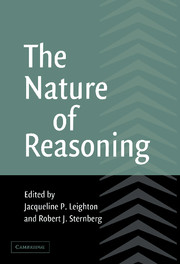Book contents
- Frontmatter
- Contents
- List of Contributors
- PART ONE THE BASICS OF REASONING
- PART TWO THE WORKINGS OF REASONING
- PART THREE THE BASES OF REASONING
- 11 The Assessment of Logical Reasoning
- 12 The Development of Deductive Reasoning
- 13 The Evolution of Reasoning
- 14 Individual Differences in Thinking, Reasoning, and Decision Making
- 15 Teaching Reasoning
- 16 What do We Know about the Nature of Reasoning?
- Index
15 - Teaching Reasoning
Published online by Cambridge University Press: 05 July 2011
- Frontmatter
- Contents
- List of Contributors
- PART ONE THE BASICS OF REASONING
- PART TWO THE WORKINGS OF REASONING
- PART THREE THE BASES OF REASONING
- 11 The Assessment of Logical Reasoning
- 12 The Development of Deductive Reasoning
- 13 The Evolution of Reasoning
- 14 Individual Differences in Thinking, Reasoning, and Decision Making
- 15 Teaching Reasoning
- 16 What do We Know about the Nature of Reasoning?
- Index
Summary
As used in the psychological literature, reasoning has a variety of connotations that differ in their inclusiveness. At one extreme, the term is used to connote what once was called ratiocination, the process of deductive inferencing. At the other, it encompasses many aspects of thinking, in addition to deduction, that are involved in drawing conclusions, making choices, solving problems, and trying to figure out what to believe. Researchers and educators who have written about the teaching of reasoning have, I believe, had relatively inclusive connotations of reasoning in mind when doing so, and it is reasoning in a broad sense that is of interest here.
SOME DISTINCTIONS
Among many distinctions that have been made regarding reasoning by philosophers and psychologists, perhaps none is more basic than the distinction between deduction and induction. Deduction involves making explicit in conclusions what is contained by implication in the premises of an argument; induction, in contrast, involves going beyond what is implicitly contained in the evidence from which conclusions are drawn. Polya (1954a, 1954b), whose distinction between demonstrative and plausible reasoning is essentially the same as the distinction between deduction and induction, characterizes the distinction as the difference between reasoning that is “safe, beyond controversy, and final” and that that is “hazardous, controversial, and provisional.”
- Type
- Chapter
- Information
- The Nature of Reasoning , pp. 410 - 442Publisher: Cambridge University PressPrint publication year: 2003
- 2
- Cited by



